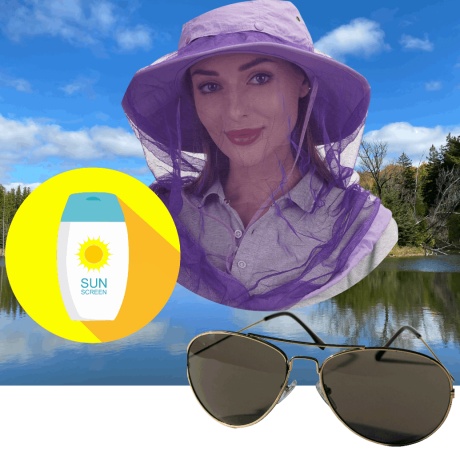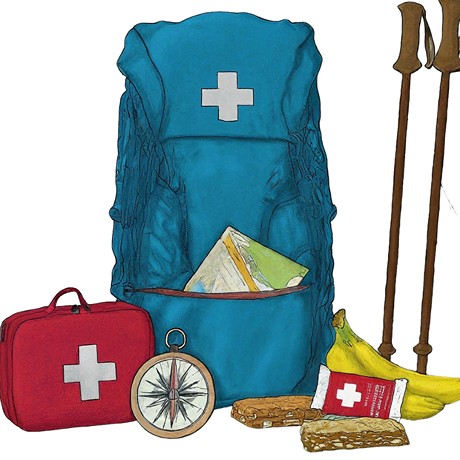
Warm Weather Hiking: 6 Tips to Beat the Heat & Bugs!
Contents
Sunshine, warm breezes, and the call of the wild – spring and summer beckon outdoor enthusiasts to hit the trails. But with warm weather comes the challenge of staying comfortable and avoiding pesky mosquitoes. Happy Trails, No Itch! here are 6 Tips to pack for your hike.
- Moisture-wicking fabrics: Ditch the cotton! Opt for synthetic materials like polyester or nylon that pull sweat away from your skin, keeping you cool and dry.
- Light and loose: Baggy clothes allow for airflow and greater range of motion. Light-colored clothing reflects sunlight and is less attractive to mosquitoes (a bonus!). Look for shirts, shorts, and pants in light colors like white, tan, or khaki.
- UPF-Rated Clothing: Consider clothing with a UPF (Ultraviolet Protection Factor) rating. UPF 15, UPF 30, and UPF 50+ fabrics provide guaranteed sun protection.
- Layering system: Even in warm weather, mornings can be chilly and mountain breezes unexpected. Pack a lightweight long-sleeved shirt and a packable rain jacket for versatility.
Based on our years of hiking experience and thorough research on various products on the market, we have compiled a list of the most cost-effective hiking dresses for warm weather below.

Price: $29.98 - $39.98

Price: $64.99 - $104.16

Price: $45.28 - $51.29
2. Sun Protection is Non-Negotiable:

- Sunscreen: Broad-spectrum SPF 30 or higher is a must-have. Apply liberally and reapply every two hours, or more often if sweating or swimming.
- Sunglasses: Protect your eyes from UV rays with a good pair of sunglasses. Polarization helps reduce glare.
- Hat: A wide-brimmed hat shades your face, neck, and ears, preventing sunburn and heatstroke. Shield your head from hungry mosquitos with a cool hat and veil!
Here are some of our favourite wide-brimmed hats that are both sun-protective and insect-repellent. We hope this helps you find the perfect hat for your needs!
Price: $38.99
Price: $28.99
Price: $19.99
Price: $21.99 - $29.99
3. Beat the Bite: Mosquito Hacks for Hikers

Mosquitoes can turn a delightful hike into a swatting frenzy. Here’s how to outsmart those pesky insects:
- Dress for Defense: Cover up with long pants, long-sleeved shirts, and socks, especially at dawn and dusk when mosquitoes are most active. Opt for loose-fitting, light-colored clothing that provides comfort and deters mosquitoes. Wearing a hat with a mosquito veil is a smart way to keep those pesky bugs away. 🌿🦟
- Treat Your Clothes: Permethrin (always follow label instructions!) is an EPA-registered insecticide that can be applied to clothing for long-lasting protection against mosquitoes and ticks.
- Repellent is Your Friend: Choose an EPA-registered insect repellent containing DEET, picaridin, or oil of lemon eucalyptus. Choose a concentration appropriate for the expected mosquito intensity and reapply according to the label instructions.
- Natural Options (with limitations): Consider citronella candles for a small perimeter of defense around your campsite (be aware that wind can significantly reduce their effectiveness). Sprays with natural ingredients like lemon eucalyptus oil or citronella may offer some protection, but their effectiveness is generally lower than DEET-based repellents.
Here is a list of mosquito repellents that we have used and found to be effective. We hope this helps you choose the best one for your needs.
Off! Deep Woods Insect Repellent is a DEET-based repellent that is effective for up to 8 hours. It is available in a variety of forms, including sprays, lotions, and wipes.
PiACTIVE – DEET FREE – Insect Repellent Lotion is a picaridin-based repellent that is effective for up to 12 hours. It is also available in a variety of forms.
Ben’s 30% DEET Mosquito, Tick and Insect Repellent is a DEET-based repellent that is effective for up to 6 hours. It is a good option for people with sensitive skin.
Natrapel Lemon Eucalyptus Insect Repellent is a plant-based repellent that is effective for up to 6 hours. It is a good option for people who prefer a natural alternative to DEET.

Price: $16.41

Price: $21.53
When choosing a mosquito repellent, it is important to consider the following factors:
- The length of time you will be outdoors. If you will be outdoors for more than a few hours, you will need a repellent that is effective for a long period.
- The type of mosquitoes in your area. Some mosquitoes are more resistant to repellents than others.
- Your personal preferences. Some people prefer DEET-based repellents, while others prefer plant-based repellents.
It is also important to follow the directions on the label of the repellent you choose. This will help ensure that you are using the product safely and effectively.
- Be Aware of Peak Mosquito Times: Mosquitoes are most active around dawn and dusk. If possible, plan hikes or outdoor activities during the day when they’re less prevalent. Seek shelter in a tent, car, or other enclosed area if you encounter a swarm.
By following these tips, you can help protect yourself from mosquito bites and the diseases they can carry.
4. Footwear: Comfort for the Long Haul

- Hiking Boots or Shoes: Choose footwear with good ankle support and traction. Waterproof, Breathable trail shoes work well for shorter hikes, while hiking boots provide extra stability for longer treks.
- Socks: Opt for synthetic or Merino wool socks to prevent blisters. These materials wick away moisture and keep your feet dry.
Based on our years of hiking experience and thorough research on various products on the market, we have compiled a list of the most cost-effective hiking dresses for warm weather below.
Price: $83.67 - $190.00
Price: $62.73 - $405.00
Price: $43.09 - $145.00
Price: $141.71 - $230.00
5. Hydration is Key:

- Water bottle or hydration pack: Carry enough water for the length and difficulty of your hike. Aim for at least half a litre per hour on moderate hikes. Consider a hydration pack for easy access while you move.
- Electrolytes: Especially on longer hikes, consider electrolyte tablets or sports drinks to replenish essential salts lost through sweat.
Stay hydrated on the go with these awesome hydration packs! Find the perfect one for your adventures.

Price:$63.95 - 110.38
6. The Essentials for a Safe Adventure:

- Daypack: Choose a comfortable pack sized for your needs. A good rule of thumb is 20-30 litres for day hikes.
- Navigation: Even on familiar trails, bring a map and compass or a GPS device. Knowing how to use them is crucial.
- First-aid kit: Be prepared for minor injuries with a basic first-aid kit.
- Snacks:Pack enough high-energy snacks to keep you fueled throughout your hike. Think nuts, granola bars, or trail mix.
- Trekking poles: These can improve balance, reduce stress on knees, and help propel you uphill.
Based on our years of hiking experience and thorough research on various products on the market, we have compiled a list of the most cost-effective hiking dresses for warm weather below.
Price: $79.97
Price: $38.98

Price: $64.99 - $74.99
Price: $38.99 - $45.99
Remember, acclimatizing to high heat takes time, so take it slow on your first few warm-weather hikes. By following these tips, you can ensure your warm-weather hikes are enjoyable, comfortable, and (almost) itch-free. Stay safe, get out there, explore the trails, breathe in the fresh air, enjoy the views, and embrace the beauty of nature! 🌞🏞️









